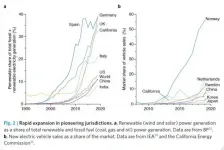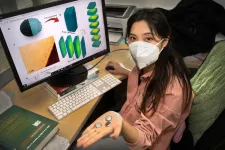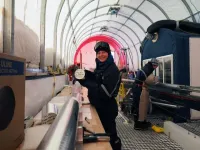Cultural, belief system data can inform gray wolf recovery efforts in US
2021-06-03
(Press-News.org) Humans regularly exert a powerful influence on the survival and persistence of species, yet social-science information is used only sporadically in conservation decisions.
Researchers at Colorado State University and The Ohio State University have created an index depicting the mix of social values among people across all 50 states, providing data that can be useful for wildlife conservation policy and management.
As a specific illustration, the research team found a supportive social context for gray wolf reintroduction in Colorado. Last fall, citizens in the state voted by ballot initiative to mandate the reintroduction of gray wolves. The data and maps in the study reveal that Colorado's social environment is far more conducive to wolf recovery than states like Montana and Idaho, which currently have state legislative efforts to reduce wolf populations.
The study, "Bringing social values to wildlife conservation decisions," was published online June 3 in Frontiers in Ecology and the Environment.
Michael Manfredo, the study's lead investigator and head of CSU's Department of Human Dimensions of Natural Resources, said the research reveals how people fall into the categories of traditionalists - those who believe animals should be used for purposes that benefit humans, like hunting and medical research - or mutualists, those who believe that animals deserve the same rights as humans. Mutualists view animals as companions and part of their social networks and project human traits onto animals.
"You can see what the 'flavor' is of the state or county, and what policies or initiatives people are likely to support or be opposed to," said Manfredo.
Highly modernized states, including California, Nevada, Colorado and Washington, are leaning more toward mutualism, according to the research. North Dakota, Wyoming and Montana have more residents with traditionalist values.
Tara Teel, CSU professor and a lead author on the study, said that the data is relevant for other hot and new topics and drills down to the county level.
"This study builds on a 50-state study on America's Wildlife Values -- the largest and first of its kind," said Teel. "It is one of the first broadly accessible social science datasets to inform wildlife conservation efforts across the United States."
Data provides insight on conservation decisions
While the results are particularly relevant for the U.S., the technique used by the team could be applied to better account for human factors in conservation decisions for addressing issues like climate change, species reintroductions and human-wildlife conflict globally.
The research team used data from a survey conducted from 2017 to 2018 of 46,894 U.S. residents and applied a sociocultural index to inform decision-making through an understanding of public values toward wildlife. Scientists measured mutualist and traditionalist values, which have previously been shown to be highly predictive of attitudes on a wide range of policy issues. The team subsequently developed state and county maps.
'Values don't change quickly'
"Previous research has found that there is a strong relationship between the laws passed in any given state and people's values," said Manfredo. "In the last two decades, there's been a substantial change in how people value wildlife," he added.
"Values don't change quickly," he said. "They're not like how a person feels about political issues. Values are formed in a person's youth and stay with you forever."
Manfredo said data showed that as far back as the early 2000s, people in Colorado were in favor of wolf reintroduction. But in places like Jackson County, a sub-alpine valley in northern Colorado, people were not so excited about wolves.
"Society is changing, and there's been a backlash from traditionalists who feel that their values and their voices in decision-making are being threatened," he said. "Ultimately, state and local agencies need to pay more attention to constituents. That means everybody in the state, not just a segment or a particular county. Policies need to fall more in line with the values of the public."
INFORMATION:
[Attachments] See images for this press release:

ELSE PRESS RELEASES FROM THIS DATE:
2021-06-03
NEW YORK CITY, June 2, 2021 -- New research from Memorial Sloan Kettering Cancer Center (MSK) medical oncologist Dean Bajorin, MD, and colleagues found that patients who received nivolumab (Opdivo®) after bladder cancer surgery reduced their overall risk for high-grade bladder cancer recurrence. This research was published in the New England Journal of Medicine.
In this phase III randomized study, Dr. Bajorin and a team of investigators evaluated 709 patients who were at high risk for recurrence of urothelial cancer after removal of their bladder, ureter, or kidney for high-grade cancer. To evaluate for benefit, patients were randomized to receive either nivolumab or a placebo every two weeks for one year. Patients and ...
2021-06-03
A complex zone of folding and faulting that links two faults underneath downtown Salt Lake City could deform the ground during a large earthquake, according to a new study.
The findings, published in the open-access journal The Seismic Record, suggest that earthquakes magnitude 5.0 and larger could cause ground displacement and liquefaction in Salt Lake City that increase the risk of earthquake-related building damage.
As part of the Wasatch Fault Zone, the region has a complex seismic history, with at least 24 large earthquakes occurring in the urbanized parts of the zone over the past 7000 years. Along with previous excavation, borehole and other geophysical studies, the new research also supports the possibility of through-going ruptures ...
2021-06-03
At the upcoming Conference of the Parties (COP26) in November, ample discussion is likely to focus on how the world is not on track to meet the Paris Agreement's goals of stopping warming at well below 2°C. According to a new University of California San Diego article published in Nature Energy, world diplomats will, however, find encouraging signs in emerging clean energy technology "niches"--countries, states or corporations--that are pioneering decarbonization.
"In certain areas, adoption rates for solar and wind turbines, as well as electric vehicles are very high and increasing every year," write the authors of the opinion piece Ryan Hanna, assistant research scientist at UC San Diego's Center ...
2021-06-03
TAMPA, Fla. -- There are several new treatment options available for patients with advanced melanoma. While these therapies have greatly improved the prognosis for patients, each person can respond to the treatments differently. Treatment of melanomas that have spread to the central nervous system is especially challenging. In a new article published in Clinical Cancer Research, Moffitt Cancer Center researchers reveal how different therapies impact the surrounding immune environment of metastatic melanoma tumors according to location and identify a rare population of immune cells that is associated with improved overall survival.
Different types of cancer tend to spread to specific sites throughout the body. Common sites of melanoma ...
2021-06-03
The pros make it look easy, but making a movie with a drone can be anything but.
First, it takes skill to fly the often expensive pieces of equipment smoothly and without crashing. And once you've mastered flying, there are camera angles, panning speeds, trajectories and flight paths to plan.
With all the sensors and processing power onboard a drone and embedded in its camera, there must be a better way to capture the perfect shot.
"Sometimes you just want to tell the drone to make an exciting video," said Rogerio Bonatti, a Ph.D. candidate in Carnegie Mellon University's Robotics Institute.
Bonatti was part ...
2021-06-03
North Carolina State University researchers have developed a computer simulation tool to predict when and where pests and diseases will attack crops or forests, and also test when to apply pesticides or other management strategies to contain them.
"It's like having a bunch of different Earths to experiment on to test how something will work before spending the time, money and effort to do it," said the study's lead author Chris Jones, research scholar at North Carolina State University's Center for Geospatial Analytics.
In the journal Frontiers in Ecology and the Environment, researchers reported on their efforts to develop and test ...
2021-06-03
KINGSTON, R.I. - June 3, 2021 - Scientists from the University of Rhode Island have taken the first steps toward understanding the function of microbes that live on and in Eastern oysters, which may have implications for oyster health and the management of oyster reefs and aquaculture facilities.
"Marine invertebrates like oysters, corals and sponges have a very active microbiome that could potentially play a role in the function of the organism itself," said Ying Zhang, URI associate professor of cell and molecular biology. "We know very little about whether there are resident microbes in oysters, and if there are, what their function may be or how they may help or bring harm to the oyster."
Zhang and doctoral student Zachary Pimentel extracted the DNA of microbes living in ...
2021-06-03
ANN ARBOR, Mich. -- A different type of surge may be on the way more than a year into the pandemic - a baby surge.
The COVID-19 shutdown initially seemed to hit pause on pregnancy and birth rates, new research from one major hospital system suggests, but that trend is quickly reversing.
"Birth rates declined early on in the pandemic, but we expect a dramatic rebound soon," says lead author Molly Stout, M.D., MSci, maternal fetal medicine director at Michigan Medicine Von Voigtlander Women's Hospital.
"We're already seeing signs of a summer baby surge."
While infectious ...
2021-06-03
UPTON, NY--A team of researchers led by chemists at the U.S. Department of Energy's (DOE) Brookhaven National Laboratory has studied an elusive property in cathode materials, called a valence gradient, to understand its effect on battery performance. The findings, published in Nature Communications, demonstrated that the valence gradient can serve as a new approach for stabilizing the structure of high-nickel-content cathodes against degradation and safety issues.
High-nickel-content cathodes have captured the attention of scientists for their high capacity, a chemical property that could power electric vehicles over much longer distances than current batteries support. Unfortunately, the high nickel content also causes these cathode materials to degrade more quickly, creating cracks ...
2021-06-03
The South Pole and the rest of East Antarctica is cold now and was even more frigid during the most recent ice age around 20,000 years ago -- but not quite as cold as previously believed.
University of Washington glaciologists are co-authors on two papers that analyzed Antarctic ice cores to understand the continent's air temperatures during the most recent glacial period. The results help understand how the region behaves during a major climate transition.
In one paper, an international team of researchers, including three at the UW, analyzed seven ice cores from across West and East Antarctica. The results published June 3 in Science show warmer ice age temperatures in the eastern part of the continent.
The team ...
LAST 30 PRESS RELEASES:
[Press-News.org] Cultural, belief system data can inform gray wolf recovery efforts in US





